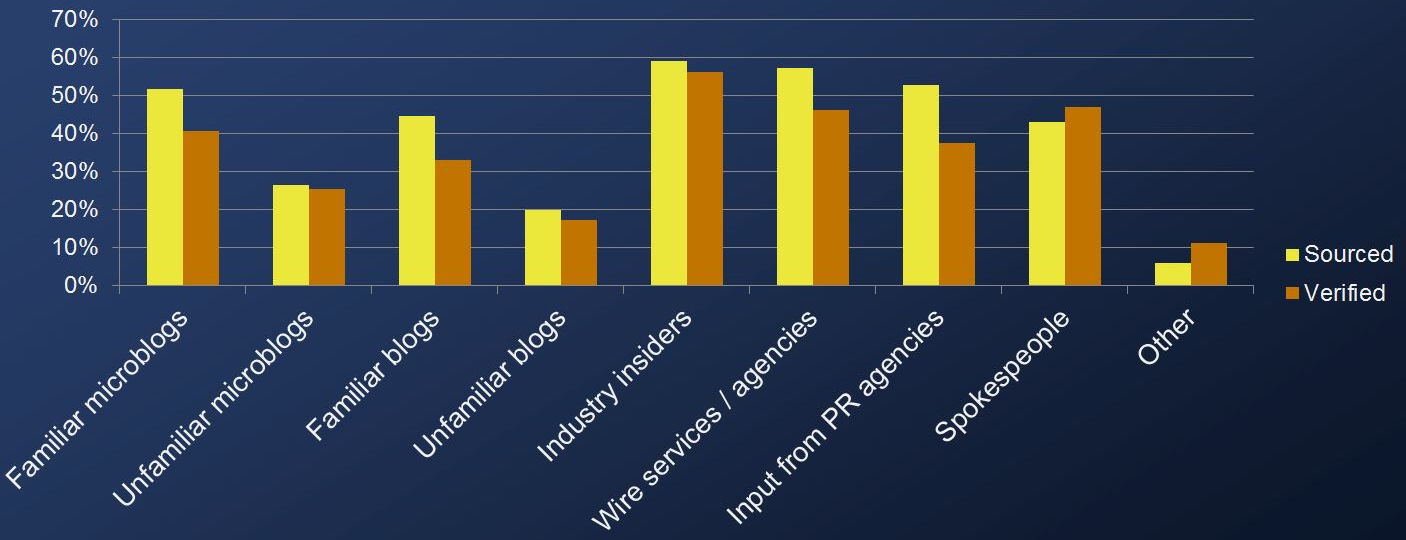In the last three years there have been dramatic changes in how publications gather and communicate their stories claims the latest Brands2Life Digital Journalism Study. For example, over half (51 per cent) of journalists across the world say they use micro blogs (including Twitter and Facebook) for news stories, provided the source behind those accounts is known and trusted. When it comes to publishing news items, there is policy of “breaking news online as it happens” in place at over a third of the media titles surveyed.
Which of the following do you use to source news stories; which do you use to verify stories you're already working on?

Source: Oriella Digital Journalism Study
The UK and Canada are the countries where journalists have most keenly taken to social media newsgathering, with nearly two thirds (68 per cent) of journalists using social media, provided the sources are trustworthy. Despite the importance of social media in news writing, the most important sources of news and validation remain conversations with industry insiders.
Robin Grainger, director, International at Brands2Life, says: “Our study suggests 2013 is a watershed year for the world’s media. The growing interest in ‘digital-first’ reporting, video, real-time news, mobile content and citizen journalism all exemplify what we’re calling the ‘new normal for news’.
“If these trends accelerate, there are some potentially game-changing ramifications for media and communicators alike. First, touch-screen interfaces will open up new possibilities for storytelling. Second, we may see a polarisation of journalistic output. At one end short, ‘tweet-like’ news updates will provide near real-time coverage of events in print and on video, optimised for small screens. At the other end, we may see much longer-form feature and investigative pieces. ‘Shorter but quicker’ journalism could also afford media brands greater prominence – and consequently greater traffic – in search rankings, news readers and ‘social news aggregator’ apps such as Flipboard and Pulse News.”
Press releases are not a popular way to get news, as only 7 per cent of journalists say their press release in-tray is their first port of call when they are researching a story. There has also been a big fall in the use of corporate spokespeople, from 24 per cent in 2012 to 16 per cent this year.
How far do you trust the following individuals in your research?

Source: Oriella Digital Journalism Study
Some more bad news for PROs is that they are not considered a trusted source of information. Grainger lists the sources most, and least trusted by journalists: “The sources most trusted are academics and other experts, who are trusted by 70 per cent of journalists; technical experts in companies (trusted by 63 per cent) and analysts (trusted by 49 per cent). Company CEOs are trusted by only 41 per cent, and actually distrusted by one journalist in eight. The least trusted individuals are politicians, PR officers, heads of marketing, and community managers – all of whom were more distrusted than trusted by journalists.”
Methodology
The Oriella Digital Journalism Study was first conducted in 2008 and tracks the adoption of social and digital technologies in the media sector. This year’s study – the sixth – was compiled in March and April 2013 using an online survey of 553 journalists in 15 countries from broadcast, national, lifestyle, regional and trade media and blogs in Australia, Brazil, Canada, China, France, Germany, India, Italy, New Zealand, Portugal, Russia, Spain, Sweden, United Kingdom and the United States. On average 37 journalists were surveyed in each country.
PR Masterclass: The Agency Growth Forum
Our experts will each give you a 20-minute Masterclass on what we've identified as the 11 most important elements in running a modern, profitable and successful PR firm.
Taking place on Wednesday 26th November in London, both virtual and in person tickets are available.
Tickets on sale now!
PR MasterclassIf you enjoyed this article, sign up for free to our twice weekly editorial alert.
We have six email alerts in total - covering ESG, internal comms, PR jobs and events. Enter your email address below to find out more:









